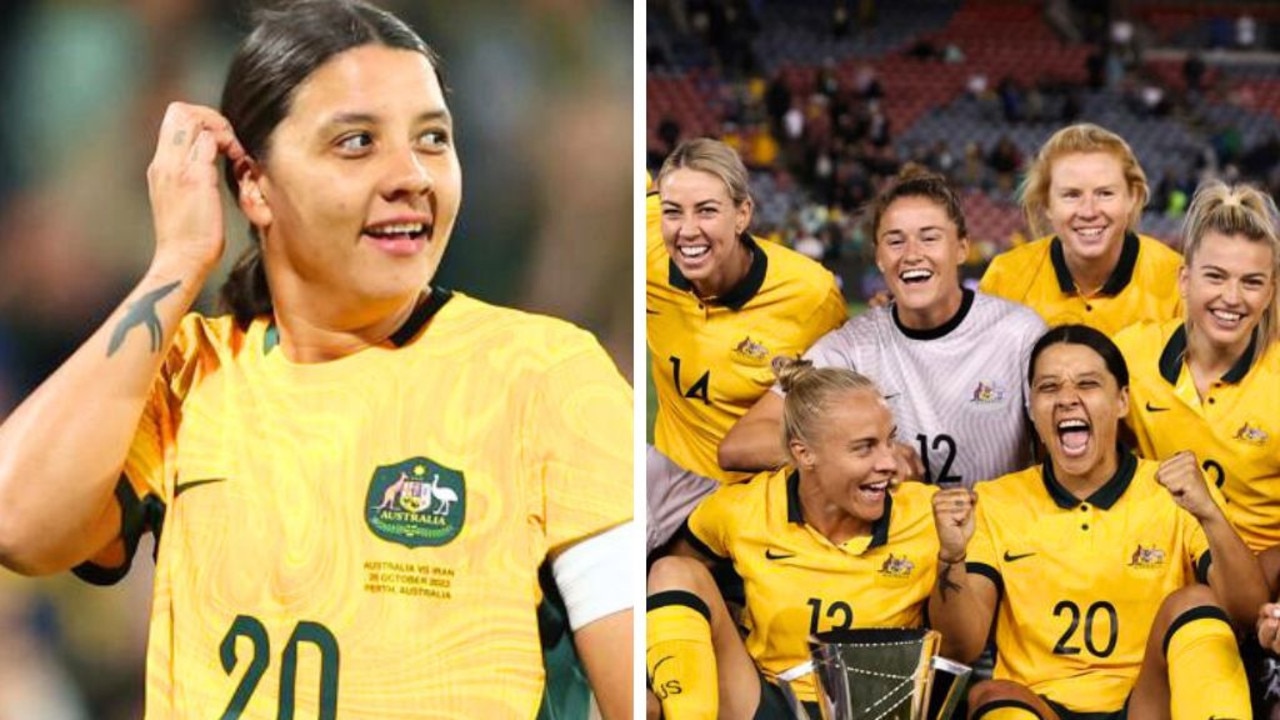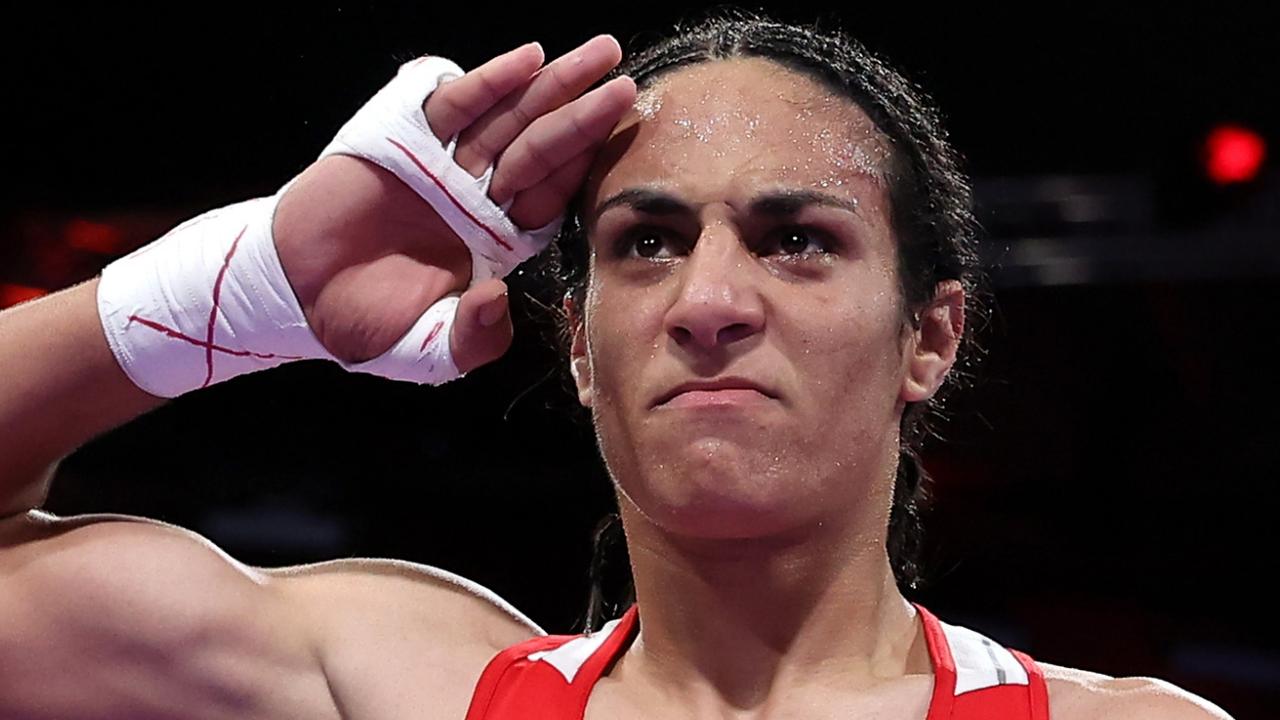Guus Hiddink’s Socceroos visit this week has inspired Socceroos and Graham Arnold as World Cup approaches
“Old stories are nice in the pub.” Guus Hiddink hasn’t arrived in Australia just to talk about the good old days, writes ADAM PEACOCK.
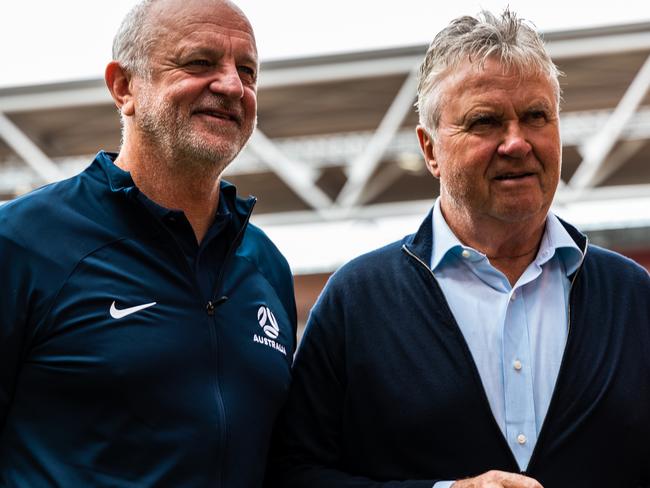
Sport
Don't miss out on the headlines from Sport. Followed categories will be added to My News.
Guus Hiddink didn’t want to delve into the past too much.
“Old stories are nice in the pub with a beer,” the Dutchman tried to assure an eager audience. “But now is now.”
And yet he couldn’t help himself.
Hiddink, the master, was reunited with Graham Arnold, his old apprentice, on Wednesday.
For more than half an hour, the two lit up a stale press conference room in the bowels of Suncorp Stadium with tales from the past, stories which remain relevant in the present.
Hiddink, famously, masterminded Australia’s exit from three decades of pain and punishment to propel them into the 2006 World Cup.
By his side as his assistant, confidant and conduit to Australian culture, was Arnold.
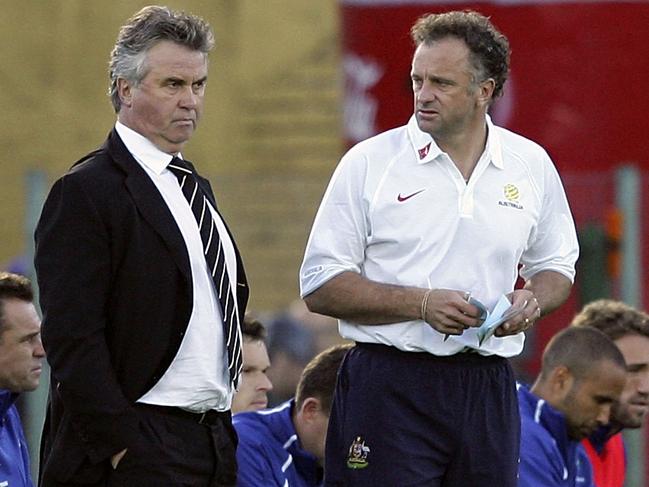
And since the most revered period in the 100-year history of the national men’s football team, when Australia qualified to take on the world, and shocked it by making the knockout stages, the Socceroos haven’t missed a World Cup since.
Arnold, with Hiddink’s teachings forming a huge part of his football philosophy, guided the Socceroos through a treacherous qualifying campaign, which went down to a penalty shootout against South American opposition.
Peru, not Uruguay were banished.
Same, same, but different.
Since 2006, the Socceroos haven’t progressed from the group stages at a World Cup. Everyone is sick of the participation award.
Success at this World Cup is to emulate 2006.
So for this week’s final two games of preparation against New Zealand before November’s showpiece, Arnold called on a friend and mentor.
To look back. And forward.
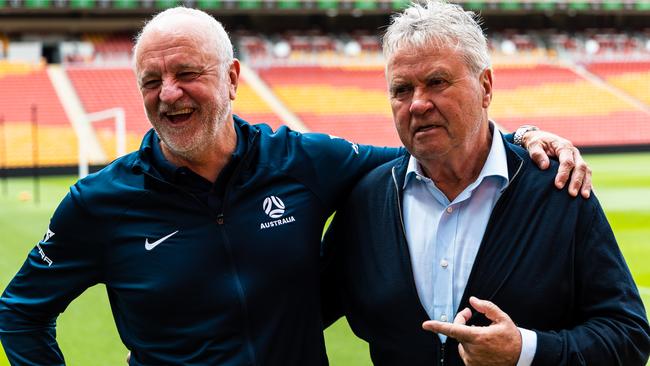
*****
Hiddink hasn’t visited Australia since 2015, when he attended a 10-year anniversary dinner of the Uruguay qualification in 2005. The Dutchman has kept in regular touch with Arnold, especially since he took the Socceroos job in 2018.
Hiddink’s tactical DNA, and approach to preparing for games, is closely related to what Arnold values as non-negotiables, and for every instance Arnold has from the present or is planning for the near future, Hiddink can relate it to a story from his time in charge with the Socceroos.
“Australia is a team who likes to play in an attacking way,” Hiddink observes. “But you have to be organised defensively. Then you have the spirit to harm the opponents.”
Those words are the forward passage to Arnold’s tactical playbook.
Arnold wants the Socceroos to look forward and play forward, while at the same time ensuring correct positioning and awareness should possession be lost, in order to prevent danger.
It’s how he achieved success at Central Coast and Sydney FC.
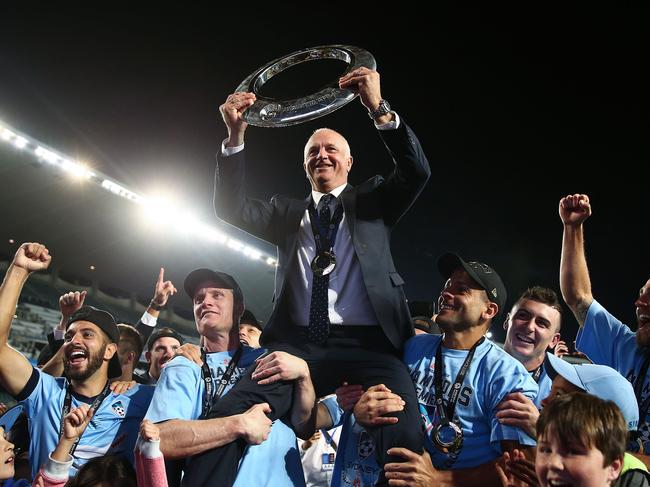
It was the basis for an inspired performance against Peru.
Criticism follows Arnold from some quarters because it’s not how Ange Postecoglou coaches. But it’s how Hiddink went about management. It worked for the Dutchman. A European Cup with PSV Eindhoven. Dutch championships. Overachieving in World Cups with South Korea and Australia.
Aside from a shared philosophy, Arnold learned from Hiddink the benefits of having a Plan A, B, C, D and E, which is evident in the idea of substituting a goalkeeper for a penalty shootout.
Hiddink, in 2005, was considering replacing Mark Schwarzer with Zeljko Kalac for the Uruguay shootout. Brett Emerton cramping and taking the last sub stopped the plan.
He coyly admitted on Wednesday he wouldn’t have had the guts to do it.
Seventeen years later, the Andrew Redmayne experiment did happen.
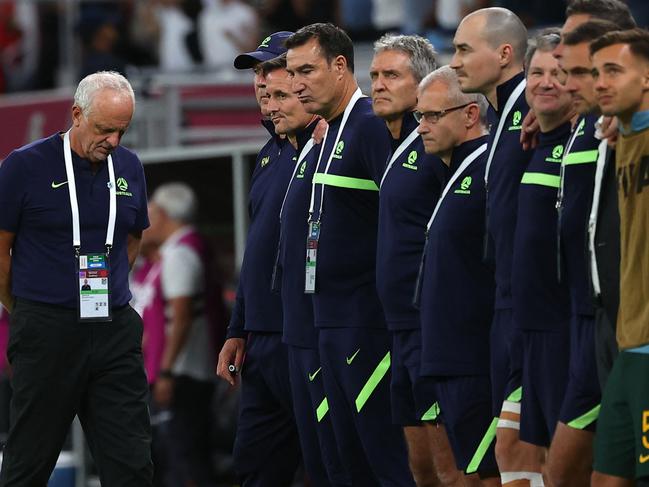
Hiddink also broke into a story about his first experience with the Socceroos as a four-day camp in August of 2005 in Holland. He couldn’t believe it as players started smashing each other in tackles on the pitch. It came to blows.
When reminded that combative midfielder Vince Grella may have been involved, Hiddink then broke into his vault again and brought out the yarn of when Grella smashed Michael Essien in a Premier League game, when Hiddink was in charge of Chelsea.
Grella, on the floor, made eye contact with Hiddink and gave a smile and a thumbs up.
“The spirit is always there with the Australians,” Hiddink laughs.
Spirit was a theme in June. Not so much in a combative manner, but rather a steel-like bond forged in the ten-day camp before the Peru game.
“I’m very proud of him,” Hiddink says of Arnold’s achievement. “Respect him very much, if you see how he made it with the Olympic team as well, chapeau.”
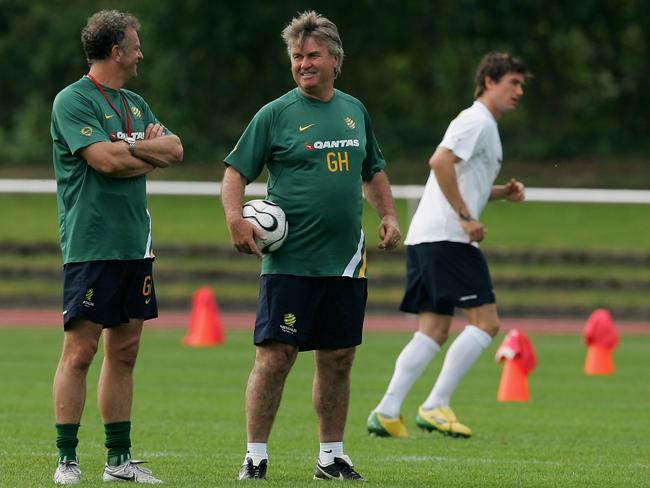
*****
Hiddink was a master at getting teams ready for tournament play. In 2002, he had Korean authorities postpone the K League so he could make the national team like a club team and have months of preparation for the World Cup.
They ran through brick walls to make the semi-finals.
It was an achievement not reached before or since.
And then in 2006, Hiddink prepared the Socceroos brutally. Players from that era still shiver at some of the training camp days, endless running, and constant demands without any hint of a shortcut.
This World Cup is markedly different: Arnold has this camp for two games against New Zealand then won’t see his players for an extended period.
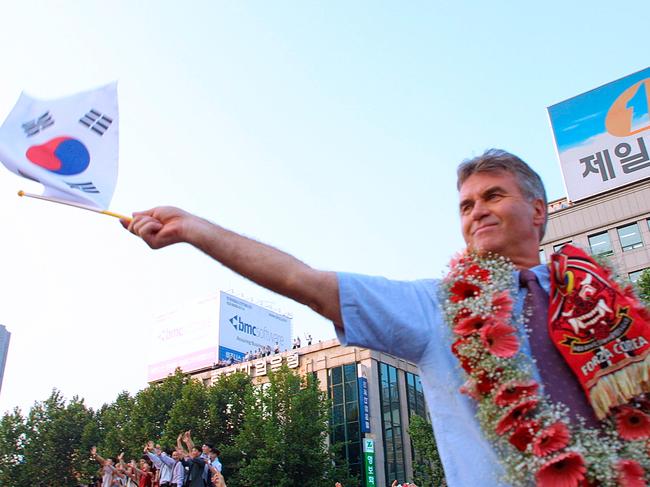
Ground rules have been laid bare in team meetings.
Be fit, or you won’t be picked.
“We need the fittest, the freshest and the best,” Arnold says of who will make his 26-man World Cup squad. “Guus’ eyes for this camp can be a real bonus for that.”
Hiddink adds: “It’s more complicated now.
“(Arnold) did a beautiful job to qualify and now he’s depending a bit on how they practice in their clubs. They seem to be very fit and fresh. No doubt about Australians they are fresh in the mind. They fight, they fight.”
The experienced element of the current Socceroos squad had barely hit adolescence when Hiddink was in charge. Some, like Garang Kuol, weren’t even born. But his lessons will make for fascinating listening over the next two days in camp.
“I just met him briefly for the first time. Buzzing!” enthused Jackson Irvine to CODE Sports.
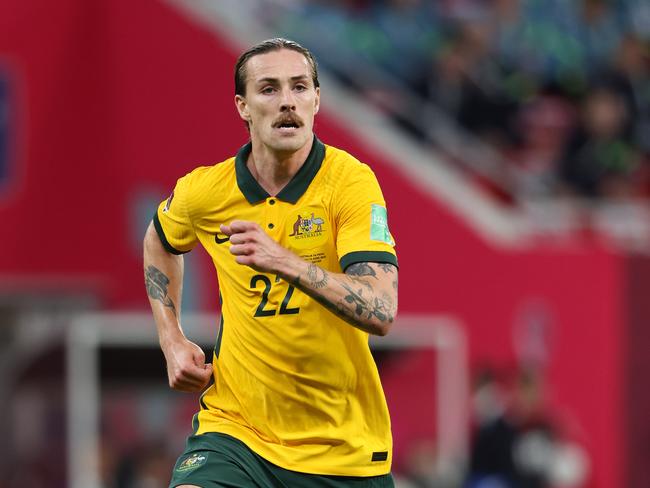
Irvine was in the stands as a football-mad 12 year-old for the Uruguay game in 2005. He then convinced his parents to take him to the World Cup.
Now a key cog in Arnold’s midfield, Irvine gets to swap stories with a legend.
“Absolute icon of the sport,” he says. “Hoping I get a time to share my memories as a fan at some point.”
Hiddink, who has now officially retired from management after a 35-year career, will sit next to Arnold on the bench for Thursday’s game against New Zealand.
One of Hiddink’s strengths was to get inside the minds of his players, and draw out from deep within a feeling within that would help performance of individual, and by proxy, team.
Mark Viduka?
He goaded him into losing weight and made him captain.
Harry Kewell?
Dropped him for the second leg against Uruguay and he came on for an inspired role.
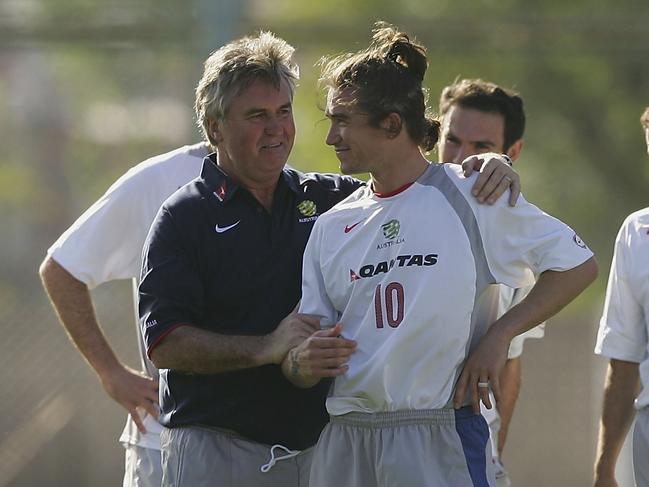
Tim Cahill?
Dropped him to the bench for the Japan game at the World Cup. He’d score twice.
From the bench next to Arnold, he’ll spot a moment of doubt, or confidence that might otherwise be missed. Hiddink maintains he won’t overstep his role.
“I’m not in charge,” Hiddink told the captive press conference.
“Yes you are,” Arnold laughed, the truth easy to find in the joke.
Originally published as Guus Hiddink’s Socceroos visit this week has inspired Socceroos and Graham Arnold as World Cup approaches


